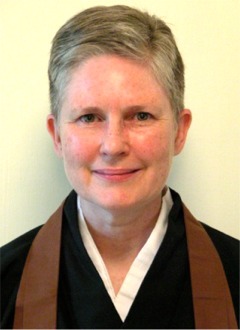
Abbess Josho's Diary: by Josho Pat Phelan |
As many of you know, I participated in a ceremony called Zuise Haito,
on December 18 and 19, at the two head training temples for Soto Zen in
Japan: Eihei-ji founded by Eihei Dogen Zenji in 1244 in Fukui
Prefecture, and Soji-ji founded by Keizan Jokin Zenji in 1324. Soji-ji
was moved to Yokahama and rebuilt in 1907, after being destroyed in a
fire.
The Zuise Ceremony is considered a way of paying respect and expressing gratitude to the two founders of Soto Zen Buddhism in Japan. I participated in Zuise with three other priests who trained at the San Francisco Zen Center, Eijun Linda Cutts, Myogen Steve Stucky, and Jaku Doyo Kinst. Zuise actually involves doing several ceremonies, at each of the monasteries, which begin with offering incense in the kaisando, or Founder’s Hall, to the monastery founder. Traditionally, the kaisando at Eihei-ji and Soji-ji are treated as an inner sanctum, and ordinarily monks will only visit the kaisando once in their lives when they do Zuise. Other ceremonies involve officiating at services, which we did together as a group. (Soji-ji formal photo below: Eijun Linda Cutts, Myogen Steve Stucky, Jaku Doyo Kinst, Josho Pat Phelan)
The day began at 4:30 a.m. with a period of zazen, followed by joining part of the monastery’s morning service. Then the Zuise participants left and began their special ceremonies which ended with having tea with the abbot or abbot’s representative. At Eihei-ji we had tea with the director of Eihei-ji who is from Hiroshima. In 2006, he was part of a group that returned a fire that had been kept at his temple in Hiroshima, having its origin in embers from the Hiroshima atomic bomb, to its source in Trinity, NM, where the first atomic bomb was tested. He led a peace march of 1,600 miles from San Francisco to southern New Mexico. Several members of the San Francisco Zen Center formally welcomed the priests to San Franciscio and joined them for the first few miles of their jmarch. The Zuise participants were given the book The Crane and the Lantern, describing this peace march, and a review of the book is reprinted toward the end of the newsletter for January and February. |
|
Our "Zuise morning" ended with a large, beautiful meal of many
small traditional Japanese dishes, one of which was deep fried kombu
(a type of seaweed) which was cut into a beautiful flower-like shape.
Reverend Yuji Ito, a priest in the Soto School Administrative Office in
San Francisco, served as our guide. His patience, kindness, and generous
spirit, as well as a knowledge of Japanese language, was a strong
support to us.
After Zuise, I visited Rinso-in, Suzuki Roshi’s temple in Japan, where his son Hoitsu Suzuki Roshi and his wife, Chitose, live with their son, Shungo-san, who is also a Zen priest, and his wife Kumi-san. It was a wonderful pilgrimage and I am deeply grateful for this opportunity which wouldn’t have been possible without the support of the Sangha. With a deep bow, Josho Pat Phelan © Copyright Josho Pat Phelan 2009 |
|

